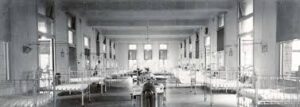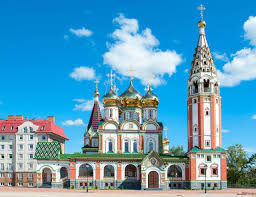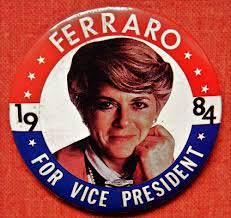What I wrote about Biden in May holds in my view, but but for one thing…
The most disturbing vision of Biden is his rear view – essentially that of an old doddering man. Then turn him around and there is that ever-engaging smile – as if he has a giant axon inside his skull that is connected to all the facial muscles, which make him smile on cue when somebody rings the metaphorical bell.
Biden is a plagiarist, discovery of which aborted his 1988 Presidential campaign. Plagiarism is a mixture of deceit and intellectual laziness – or underlying dumbness. This flaw resurfaced in certain dealings last year.
… Nevertheless, one positive sign that he is a good man is how he has handled grief and he has much to grieve about in his life.
America is in a mess; no matter when the change is made there is a White House reduced to the political nursery of the Baby Trump, and there will need to be someone very focused to clear out the rattles, the dolls, the bucket and spade, and other geegaws fondled and thrown around in the past four years.
I fear Biden just doesn’t have the ability – no fire, only embers. My earlier comments about him have not changed, and my support for Bloomberg would still hold had it not been for this entry of Obama into the frame.

He is still a fake, but fortunately Kamala Harris is authentic. I had not been paying enough attention to this very smart lawyer from California because I thought Biden would choose from the talented pool of Democratic women from the Midwestern States, even given that he was colour conscious. The residual influence of the Clintons would have been tested; the accident-prone Susan Rice in the forefront of Hilary’s list.
However, the Obama imago prevailed.
Biden is not adventurous and at 78 he has the habits of a lifetime printed in his electrical circuits. Prejudices such as showed in relation to Anita Hill bubble below the surface, despite all the meae culpae he has given. I never trust a plagiarist – it shows a level of dishonesty, subterranean it may be.
However, that pales before Trump, a person whose inability to tell the truth is well documented.
When Trump immediately attacked Kamala Harris and called her “nasty” (how pathetic can you be), he starts on the eligibility nonsense that he tried to perpetuate with Barack Obama. He is now repeating the same with Kamala Harris. In so doing, he emphasises the essential similarity between the two. One is the son of a Kenyan and white American union; the other the daughter of a Jamaican and Indian union. Coincidentally both unions broke up soon after the children were born and both had an absent father.
Trump would have preferred the traditional Tobacco Road Afro-American upon which it is easier to spew racial division and hatred.
He has a pathological antipathy to Barack. He cannot stand being mocked, his inferior intellect put to the test, his demonstrable cowardice – all in all, a vicious, corrupt guttersnipe. To put it in simple terms, he cannot bully either Harris or Obama – unlike Biden whom he has shown that he can.
There are two reasons that could be conjectured as to why Biden delayed his choice. One is that he is a natural ditherer (not a good sign in a President with so much to rectify) and the second is that he simply did not want Ms Harris. One may suspect that she is the Obama surrogate. That is not to denigrate her, but it will not be too much trouble for her to “clean up” Pence – and then unleashed she will so clearly become the President-in-waiting.
Two Vice-Presidential reactions when the President became “infirm” are relevant contrasts.
Eisenhower was 67 when he had a stroke in 1957; Woodrow Wilson was 63 when he too had a stroke in 1919. Eisenhower had nearly three years to go; Wilson the best part of two years. Richard Nixon, whom Eisenhower had foisted on him and whom really did not like much, became more prominent directly in policy decisions after 1957.
Trump is 74 and has been rushed to Walter Reed Hospital at least once; Biden is 78. Both probably are testimony to the availability of health care now in modern America, for the affluent at least, particularly in the treatment of cardiac disease and high blood pressure.
Thomas Marshall, Wilson’s Vice-President and who somewhat eerily had been the 27th Governor of Indiana (the current Vice-President Pence was the 50th), followed a different path. Again, although as with Nixon he served two terms, Marshall was disliked by Wilson and particularly by Wilson’s wife so that he was blocked from much of the day-to-day management. However, Marshall was very much his own man with seemingly a misplaced sense of noblesse oblige in refusing to take over as acting President because he feared the precedent that this action would have created.
In other words, even at an age when infirmity can strike suddenly, Biden can be tolerated because (a) Trump is so bad, probably more senile and (b) Biden has a strong deputy. However even the sight of the indecisive Biden face to face with Trump still fills me with trepidation, whereas Harris I suspect could eat Trump for breakfast and still ask for more waffles.
Is Australia prepared for the next Pandemic?
The above is the title of a paper published in April 2017 that had, as one of its authors, Brendan Murphy, whose address was given as Office of Health Protection, Australian Department of Health, Canberra.
It was published in the MJA under Perspectives and begins with the statement “infectious diseases continue to threaten global health security, despite decades of advances in hygiene, vaccination and antimicrobial therapies”. How very true!
It was a paper, which has a table of four Committees with very long names, and because they are labelled current NHMRC Centres of Excellence the assumption is that they are just that. The problem is that much of health research is encased in the gossamer of self-congratulation.

Much of medical research is somewhat like exquisite Chinese ceramics in the seventeenth century, refining the tools of the past to render more and complicated dexterity, but not advancing the human condition – defining how many angels you can fit on a pinhead – wonderful feats but of what utilitarian value?
The Murphy paper does not explicitly mention three people who have provided Australia with a buffer in the battle against infectious diseases.
The first was the emphasis by Michael Wooldridge, when he was Minister of Health, on raising the vaccination rates of Australia in the face of criminal behaviour by the anti-vaxxer brigade. Wooldridge had a strong base being close to Prime Minister Howard and being a member of the Expenditure Review Committee. Wooldridge retired and since then Federal Ministers for Health excluding Hunt have been an indifferent bunch in relation to their influence and interest (although at times Abbott showed he was across the portfolio).
The second was Dr Brian McNamee who, on assuming the role of CEO of the Commonwealth Serum Laboratories (CSL) in 1990, turned it from being a “basket case” into a world leader in the development of vaccines and blood product. As a bonus CSL is now very profitable. In so doing, McNamee cultivated Australia’s research capacity. He had a keen eye for the very best.
The third is Lindsay Grayson, whose crusade for people to wash their hands has provided a springboard for the community campaign to wash their hands. Men in particular are grubs and Grayson, first in hospitals then elsewhere, demonstrated how important hand washing is in minimising cross infection. His work has resulted in modification of health professional contact with patients.
On the flip side, governments had believed infectious disease hospitals were a thing of the past, and while HIV inpatients gave some of them a prolonged life, these hospitals dedicated to what was believed to be a relic of a past age were progressively closed down.

As I have written elsewhere I remember in the 1950s being admitted to Fairfield Hospital in Melbourne for a week for an unspecified infection, and as was the wont of the senior doctor at the time I was prescribed chloramphenicol, which was shown to have disastrous side effects. I was in isolation – quarantined – in a dedicated infectious diseases hospital, and did not escape being dosed with chloramphenicol. Nevertheless, I was well treated by a trained staff and still alive.
The New Zealand Chief Medical Officer has used the word “bespoke” in relation to quarantine facilities, especially tailored for the individual circumstance. Fairfield Hospital was just that, until it was closed by the then Premier Kennett in 1996 as a cost cutting measure, a familiar tune when it comes to public health expenditure.
The dilemma for Government now – as part of the grand exit strategy – is whether to invest in the construction of quarantine facilities. Those opposed, generally identified as central agencies, may argue there are quarantine facilities available, which were convenient when the early evacuations from China were occurring, but Christmas Island and Darwin are not the most convenient. Far more troubling for these bureaucrats is the prospect of a vaccine at a time when there is substantial hype about its prospect of success.
There are two points to keep in mind: the vaccine is far from a done deal, and there are plenty of other viruses at a time when the Climate is changing and when technology has conditioned the mood of the population to care only about Self, surrounded by Instagram or Facebook or Twitter or Tik Tok or Facetime or IsolationXbox.
However, investment in facilities now may be the price that needs to be paid to reassure Australians that our status of being a country with a low COVID-19 infection rate is preserved. It may be that the price to be paid from coming from a place of high infectivity to Australia means automatic isolation.
The paper by Murphy and his co-authors sets outs a number of Committees. Despite all the apparent impressive panoply of intellectual input set out in the paper, Australia was woefully underprepared when the Virus struck and was fortunate that our distance from the source of the original infection provided a buffer. Perhaps in hindsight, what was done there is the template for quarantine facilities to be established.
For Murphy the pamphlet of 2017 becomes the reality of 2020.
Australia just cannot be placed in permanent lockdown on the whim of some set of politicians. There is a need for a finer sieve than group punishment. If there is a lesson from this Victorian debacle it is that nobody should be allowed to visit a nursing home (or a prison) for 40 days or least a significant period after returning from abroad and not developing signs of infectious disease, then so be it. That is an obvious restriction to be put on the table, but there will be others.
The development of quarantine facilities to house the infected or those potentially infected should be near airports, and the further the airport is away from a high concentration of the people the better. There are those who wish for a vaccine, but given that viruses are coming in waves – and until this Virus struck, Australia has dodged the metaphorical bullet.
To get this whole response right is not just a case of consulting laboratory scientists whose ruminations have been effectively ignored by the community until the Virus struck. I have always taken issue with the Fabian approach of pamphleteering for change. As has been clearly demonstrated by Murphy et al in their paper, until the pandemic struck, there was no impact of these matters on the politicians. Now of course the airwaves are full of these same scientists unleashed, some able to communicate well, others not. They remain background noise while those in charge of containing the pandemic continue to work on in a social Darwinian bubble shedding the useless people whilst retaining the useful.
Wartime does not have the luxury of maintaining the idiots, just because they look good in suits. In other words, even though the cacophony of those who love show-boating remains, it is refreshing to see the “survivors”, who an observer thought from the start were competent and see some that you thought were initially incompetent improving. Hence Australia is still one of the best places to live in this Time of the Virus, even with the mistakes.
The danger is that some of the Premiers who have closed borders are caught in a competition to see who can close the longest. Closing borders becomes a mindless and sadly cruel obsession.
Now setting up, in the words of the New Zealander, a bespoke set of quarantine facilities may require less money being tossed to the other politicians-needs-a-legacy projects. I am sure the War Memorial renovations could be put on hold; and the sports stadia.

Just imagine in the Second World War John Curtin advocating for Parliament House to be transformed into the Palace of Versailles. To suggest that is so ridiculous, but Australia is in a similar crisis. The above point is to make everybody think of what is more important than the long-term health of the country – a football stadium for the inheritors of Versailles looking down from their exclusive loggia quaffing champagne and eating truffled lobster – or quarantine facilities where all the components of public health and infectious disease can be concentrated. I say again, this Virus will not be the last the infectious assault.
The solution I propose is unashamedly simple in conception but difficult in the details of implementation. I know that; unlike the following, which is barely intelligible but it is not the only vapid advice which has been published: And we might do well to remember that the wisest and most effective course of action will more often be forged in the contest of ideas than distilled from unilateral decisions untested by scrutiny and tempered by no real debate.
However, one must not get angry, rather listen to that wise local florist who noted: “when my ability to smell the rose and the eucalypt return, so will I then contemplate the frivolous.”
Once upon a time in Lithuania
In an earlier blog, I have written in some detail about our visit to the Baltic countries. However, a few comments may be relevant now that the hidden country of Belarus has emerged from behind its curtain. What is surprising is that when we drove from Estonia to Latvia and then to Lithuania we noted that there were no mountain ranges or marshes between the three countries – just nondescript borders. Yet, there are three distinct cultures, three distinct countries. All have struggled to maintain their independence, but with the breakdown of the old Soviet Union they all achieved their independence.
In 1989, to celebrate the independence from Russia on the 50th anniversary of the Molotov-Ribbentrop Pact, the people of those three countries formed a human chain stretching across all three countries from the Tikk Herman, a mediaeval Estonian fort in Tallinn, to the square in front of the Lithuanian cathedral in Vilnius.
In Vilnius, we were told that we would no longer need a visa to go to Belarus. Vilnius is close to the border and it was only a couple of hours drive to Minsk if it were not for the stringent border controls, which reflected that Belarus had never moved from its Soviet past. That was correct, we did not need a visa, but only if you flew into Minsk. It did not apply to land borders.
Belarus was once a client state of the Soviet Union and a founder member in 1945 of the United Nations as Byelorussia. Nobody talked about it and because it was translated as “White Russia” it was confused with the white Russians of the 1917 Revolution – those who opposed the Communist red Russians. So anybody who encountered the name shrugged their shoulders, “too complicated; little relevance” and turned to other matters. For Australia, there were very few migrants from there fleeing Soviet domination, unlike the Baltic Countries.

To most people Belarus (once Byelorussia) has meant nothing – a small landlocked nation of peat and farmlands, iron works and overflow Soviet manufacturing. To those who knew little, it was just a part of the Soviet Union, carved off, given a name, just to be another convenient rubber stamp, to provide another vote in the UN – to jump when the Soviets said so.
The Republic was not retained when the Soviet split up, and it was given its independence. However for Belarus, unlike their neighbours, this did not bring democracy.
So there was little surprise when a burly young former collective farm manager named Alexander Lukashenko seized power in 1994 and then, over time, consolidated his power over the population of nine million. While Yeltsin was there and in the early years of Putin, Lukashenko wanted to have his country re-absorbed into the new Russia, with himself as the Vice-President; that dream faded as Putin consolidated his personal power.
However, Byelorussia has its own language and while most people speak Russian, the country has certain differences. It is Slavic, but it has more than a pinch of Balt. It was an area, once Lithuanian as part of its empire with fortified towns. The Swedish army has tramped across it, as had the Poles. The people suffered greatly under the Soviet Union and in an article in the February 2000 Harper’s Magazine the author, who had decided to visit the Kurapaty Forest just North of Minsk, said:
“Shadows throughout the grove resolve themselves into crosses; the farther in you look the more crosses you see. Here lie the bodies of tens of thousands of Belarusians (estimates run from 30,000 to 900,000) who were executed by the Soviet authorities.” In the psyche of the Belarus people, this Soviet brutality has not been forgotten.
In 2000 Lukashenko, who had some pretensions to being an ice hockey player, was only 35 and had the support of the elderly and rural communities. His approach to government was well-defined as during that year (2000) four opposition leaders had simply disappeared.
But now in 2020 the population seems to have had enough. There is always a tipping point and Putin, if he invades, would be well aware of the cost of not only fighting but also garrisoning a hostile country, especially one where the President-in-exile is lodged in Lithuania. Furthermore, much of the countryside in the South and East has been contaminated by the Chernobyl nuclear power plant accident. Radioactive caesium is lodged in the soil.
Then there is the Russian exclave of Kaliningrad Oblast for Putin to think long and hard about if he moves on Belarus.

Kaliningrad, named after one of Stalin’s cronies, was formerly Konigsberg, the capital of Prussia. The oblast, the size of Northern Ireland, was annexed in the aftermath of World War II as a base at Baltiysk for the Russian navy, being its only ice-free port. The area is also essential for Russia’s ability to intercept and interfere with Allied communication networks – Russia’s spoiler.
Putin could move fast and send troops in to rescue Lukashenko, reckoning that his influence over Trump would stymie any Allied response involving Kaliningrad Oblast which, despite being heavily fortified, could be a risky proposition.
Currently Russia is separated from its exclave by both Belarus and Lithuania. An invasion of Belarus, unimpeded by Trump, could tempt Putin to demand a corridor across Lithuania in much the same way that Hitler demanded a corridor across Poland to the then Baltic free-port of Danzig, one of the precipitants for World War II in 1939. Lithuania is a member of the EU, and yet…there is this Manchurian candidate factor redux.
Fanciful? Better to call it out?
However, drawing breath and not wanting to wander into a nightmare more fitting of a video game, in which I am no expert; equally I am no expert in how to destroy the world to save a despot or two.
Mouse Whisper
 Geraldine Ferraro was Walter Mondale’s Vice-Presidential choice in 1984. At the time, there were many ugly rumours about the Democratic New York congresswoman relating to unpaid taxes and family links to organised crime. After all, she was of Italian extraction and from Queens at a time when the Godfather series had stereotyped Italian America – guilt by association is a favourite ploy of the media.
Geraldine Ferraro was Walter Mondale’s Vice-Presidential choice in 1984. At the time, there were many ugly rumours about the Democratic New York congresswoman relating to unpaid taxes and family links to organised crime. After all, she was of Italian extraction and from Queens at a time when the Godfather series had stereotyped Italian America – guilt by association is a favourite ploy of the media.
She decided to confront the media and answer each and every question for as long as it took – by 80 minutes she had exhausted the media and when she had finished, according to a report in the Washington Post, many of the cameramen filming applauded her.
As the Washington Post recalled this week:
There was just one critic left to deal with — the conservative columnist George Will. He had sent her roses as a sort of apology, writing in a card that, “Has anyone told you that you are cute when you’re mad?”
Ferraro called Will to thank him for the roses… But there was something she needed to say.
“Vice-Presidents aren’t cute,” Ferraro told him. And then she hung up.


Re epidemics and quarantine hospitals, which face similar problems with other small specialist hospitals. I was an intern at Fairfield Hospital and then involved in the transfer of the respiratory ward to the Austin in 1996. I was a JMO at the Peter MacCallum, and then the on-call nephrologist for 15-20 years. The problems with such hospitals are their size, an increasingly greater problem with increasing sub-specialisation and use of high tech. The patients in these hospitals have reduced, and delayed, access to these services compared to large general hospitals. The other problem is they can be more easily lead into error by strong, but misguided or ill informed leaders due to reduced group interaction. I think the best option for these types of hospitals is within, or alongside, general hospitals. The best advantage would be to have flexibility to deal with resources (beds/staff) to cope with pandemic load.